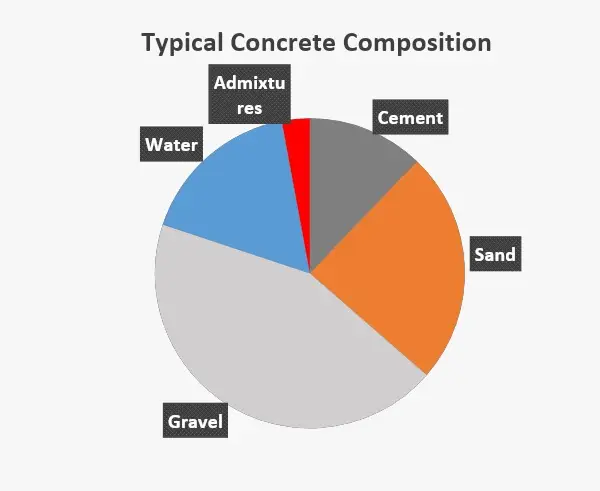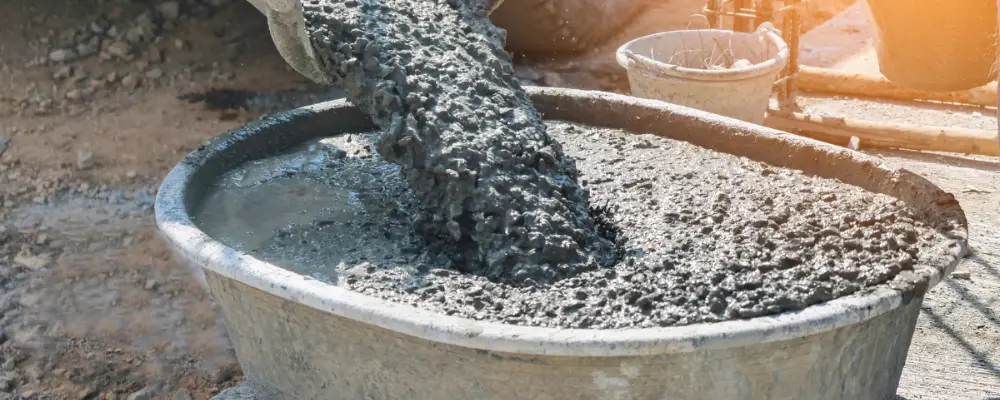Have you ever thought about the vast amount of concrete surrounding us? It’s everywhere and acts as the foundation of modern infrastructure, supporting buildings, bridges, and foundations. Imagine a building without a sturdy base – unthinkable without concrete’s foundational support. Its exceptional strength and adaptability have made it the most popular choice in construction.
Let’s explore its importance, composition, and properties further.
What is Concrete?
Concrete is the versatile building material that can be molded into any shape and and sized accordingly. Surprisingly, concrete ranks as the second most consumed material globally. Its widespread use is due to its ability to give a solid structure for different construction needs.
Concrete is a carefully balanced mixture of cement, water, sand, and admixtures, with lime in the form of hydrated lime or quicklime, sometimes added for enhanced properties. When combined perfectly, this mixture transforms into a durable, rock-like structure, earning it the nickname ‘domesticated rock’ – basically, a man-made material as sturdy as natural rock.
What is Concrete Made of?
Concrete is a fundamental building mixture consisting of 4 primary ingredients:
- Water
- Sand (fine aggregate)
- Gravel (coarse aggregate)
- Cement, typically Portland cement
Additionally, optional materials can be combined to enhance its properties, including:
- Admixtures (chemical additives)
- Lime
- Fly ash
- Fiber reinforcement materials
As concrete is made from fewer materials, it is an economical and effective choice. Moreover, the proportions of these ingredients vary depending on the specific construction purpose.
Composition of Basic Concrete Mix
The materials of concrete mix play a crucial role together in giving enhanced strength and desired properties. The proportions can be adjusted according to the local climate conditions and construction methods. Let’s explore the key materials and their roles in making a quality concrete.
Binding materials
Cement acts as the binding material in the concrete mix. It helps in binding sand and gravel together. Further, they fill gaps between particles and control shrinkage. It holds the mix together, thereby providing strength and durability. For concrete mixes, Portland cement is typically used, making up 10-15% of the total mix.
Besides cement, materials like fly ash, lime, and silica fume are used as binding materials in concrete. They enhance stability and also reduce environmental impact. Typically, they constitute 5-15% of the total concrete mix, depending on the application. They react with water and form a binding gel that complements Portland cement in holding the mix together.
Aggregates
Aggregates (sand and gravel) make up most of the concrete mix. The role of the aggregates in the concrete mix:
- Provide strength and stability
- Improve durability and resistance to wear
- Reduce shrinkage and cracking
- Enhance workability and flow
- Reduces cement usage (economically viable)
Fine aggregates (sand) usually constitute 20-30%, while coarse aggregates (gravel) make up 40-50% of the total mix.
Water
Water plays a crucial role in the concrete mix and it usually accounts for 15-20% of the concrete mix. The role of water is to
- Hydrate cement, initiating chemical reactions
- Lubricate aggregates, improving workability
- Help achieve desired consistency and flow
- Facilitate placement and finishing
Admixture
These are chemical additives that constitute 1-3% of the total mix to improve concrete’s properties. Further, they enhance performance, reduce water usage, and optimize setting time for desired results.
Cement-Water Ratio
Adding the right amount of water according to cement weight for making a concrete mix is essential, as it ensures optimal strength. If it is mixed in the wrong ratio, it can cause cracking and degradation. The correct mixture of concrete only facilitates easy placement. As per standards, the water-cement ratio varies from 0.40 to 0.60.
Example:
For a concrete mix with:
Cement: 400 kg/m³
Water: 160 kg/m³
Water-Cement Ratio = Water / Cement = 160 / 400 = 0.40
This means 0.4 kg (or 400g) of water is used for every 1 kg of cement.

Types of Concrete Mix
Concrete mix is available in various types to meet the demands of different construction projects. Let’s see the types and their applications one by one.
Reinforced Concrete
Reinforced concrete gets its name because it combines compressive strength with the reinforcing power of steel bars. This type of concrete mix is suitable for beams and columns. They provide stability to building structures and prevent cracks and shrinkage.
Due to its high load-bearing capacity, reinforced concrete is extensively used in constructing heavy buildings, bridges, and other large infrastructure projects. It is noted for its exceptional stability and durability.
Lightweight Concrete
As the name indicates, lightweight Concrete is a type of concrete mix that’s stronger but lighter. It’s made with special lightweight materials. This helps reduce the weight on buildings, keeps them cooler, resists fire, and makes them easier to build.
This concrete mix is ideal for roofs, floors, walls, bridges, and prefabricated construction projects.
High-Strength Concrete
A high-strength concrete mix has extra stability and resistance. It has 40 MPa compressive strength, roughly equal to 400 kg force per cm². It makes it ideal for multi-level buildings, bridges and auditoriums.
Precast Concrete
Precast Concrete is made in a factory and transported to site for assembling. This method speeds up construction, ensures quality, and minimises wastage. It is perfect for building walls, floors, beams, and bridge sections.
High-Performance Concrete
When compared to regular concrete mixes, High Performance Concrete exhibits superior performance and enhanced properties. It offers high resistance, durability, and endurance against environmental conditions. This makes it the best choice for high-demanding projects, such as marine structures, factories, tunnels, and tall buildings.
Properties of Concrete
Concrete mixes have distinct properties that determine their quality and suitability for various construction projects. The following are key concrete properties and their importance:
Strength
Concrete strength determines its ability to resist crushing and deformation. High strength concrete supports heavy loads and structural demands.
Durability
Concrete durability ensures its performance over time despite environmental factors. If the concrete is durable, it will minimise maintenance and extend lifespan.
Creep
Creep refers to the slow, continuous deformation of concrete under constant loads. Concrete creep impacts its ability to support long-term structural integrity.
Shrinkage
Shrinkage occurs as concrete contracts during the drying process. If it becomes uncontrollable, it will affect concrete’s integrity and appearance.
Modular Ratio
Modular ratio is the ratio of elastic modulus of concrete to steel reinforcement. It ensures compatible deformation between concrete and steel under load.
Poisson’s Ratio
Poisson’s ratio measures lateral strain response to longitudinal stress. It helps predict concrete’s behaviour under different loading conditions.
What is the Difference Between Concrete and Cement
Concrete and cement are often used interchangeably and have become common. However, it is essential to understand the difference, as engineers and experts cannot afford to use these terms with incorrect conceptions. Although they are interconnected, both have distinct applications and standards.
| Characteristics | Cement | Concrete |
| Composition | Fine powder (limestone, clay, minerals) | Mixture of Cement, water, sand, gravel |
| Function | Binder for aggregates | Provides stability and structures to infrastructures |
| Usage | Ingredient in concrete, mortar, grout | Final building material used in construction |
| Standalone Use | No | Yes |
Importance of Concrete cement
– Provides structural strength and stability to buildings and infrastructure.
– Enables durable and long-lasting construction of roads, bridges, and buildings.
– Supports urban development and high-level buildings construction.
– Ensures safety and resistance to natural disasters and extreme weather.
– Drives economic growth through efficient and cost-effective construction.
Conclusion
From the above discussion, it is clear that concrete is an integral part of our daily lives. It protects people’s lives and provides a proper landscape. Concrete has become as essential to human beings as trees and forests, fulfilling a basic need.
Its incredible role in the construction sector and its promising properties make it a widely used building material.
FAQs
Concrete strength is affected by factors such as cement quality, water-cement ratio, aggregate type, curing conditions, mixing methods, reinforcement, age, and environmental conditions.
Yes, concrete can be crushed and reused, reducing waste and saving natural resources.
Concrete typically sets within 24-48 hours but requires 28 days to achieve its full strength.

